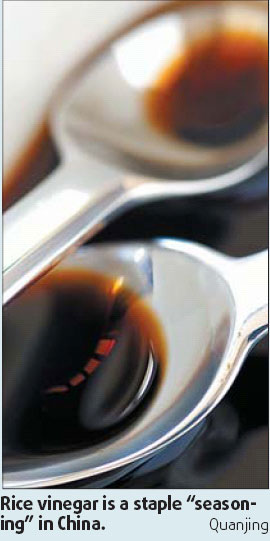This taste enhancer is also good for health
On my first afternoon in China, I sat in a small shack around the Fourth East Ring Road of Beijing and devoured my first plate of jiaozi dumplings, smacking my lips from the combination of salty soy sauce and tangy vinegar as it mingled with the fragrant pork filling. Anyway, I've pretty much been sold on Chinese vinegar ever since.

In English cuisine, plain old malt vinegar is reserved for dowsing chips, pickling onions and cleaning windows. Rice vinegar in China is a staple "seasoning" on the table, and is incorporated into a wide range of dishes and condiments with fantastic results.
The general consensus (well, amongst my colleagues) is that the best rice vinegar hails from Shanxi province, specifically from the county of Qingxu which in fact is home to the Shanxi Vinegar Culture Museum.
Most Chinese vinegars are derived from rice but Shanxi mature vinegar (Shanxi lao chencu) is brewed from a combination of sorghum, peas and barley - it is dark in color and has a particularly musty, rich flavor which works well with cold dishes, such as cold needle fish salad (lao cu zhe tou).
Chinese rice vinegar is essentially divided into three categories: black, red and white (or clear).
The black vinegar is usually made from glutinous rice although again millet or sorghum can be substituted.
This dark vinegar is great in meaty braised dishes and also makes a fantastic dipping for grilled chicken or pork ribs.
Red rice vinegar (mi cu) acquires its pale red hue from the fermentation of red yeast rice. Be sure to buy good quality red rice vinegar as some inferior brands use food dye, rather than red yeast rice itself for the coloring. Red rice vinegar has a delicate profile and is especially good in noodle soup and with seafood. I also like it mixed with a few drops of sesame oil to dress a coleslaw of finely sliced Chinese cabbage, grated carrot and ginger and toasted sesame seeds.
White or colorless vinegar (bai cu) is less acidic and milder than its European counterpart. It works well in sweet and sour dishes such as sweet and sour fish (tang cu yu). The fish is first fried whole with ginger, garlic, spring onions and a little oil, and then removed from the wok. The sauce is then made from vinegar, sugar and soybean oil which are brought to the boil before returning the fish to the pan and simmering for 5-10 minutes.
From a health point of view, vinegar of all descriptions has a fairly minimal nutrition content - no protein or fat at all and few vitamins or minerals - this does have its advantages however: Vinegar makes a good substitute to oils and high calorie dressings (such as mayonnaise) for adding flavor to hot and cold dishes without the additional fat calories.
It is also low in sodium which makes it a better alternative to table salt or soy sauce for seasoning. Furthermore, all types of vinegar are high in acetic acid which assists the absorption of minerals into the body from food it is eaten with.
This nutrition-related column is written by Nina Lenton, a qualified dietitian living and working in Beijing. Contact her at nina.lenton@ikang.com.
(China Daily 04/23/2008 page19)














